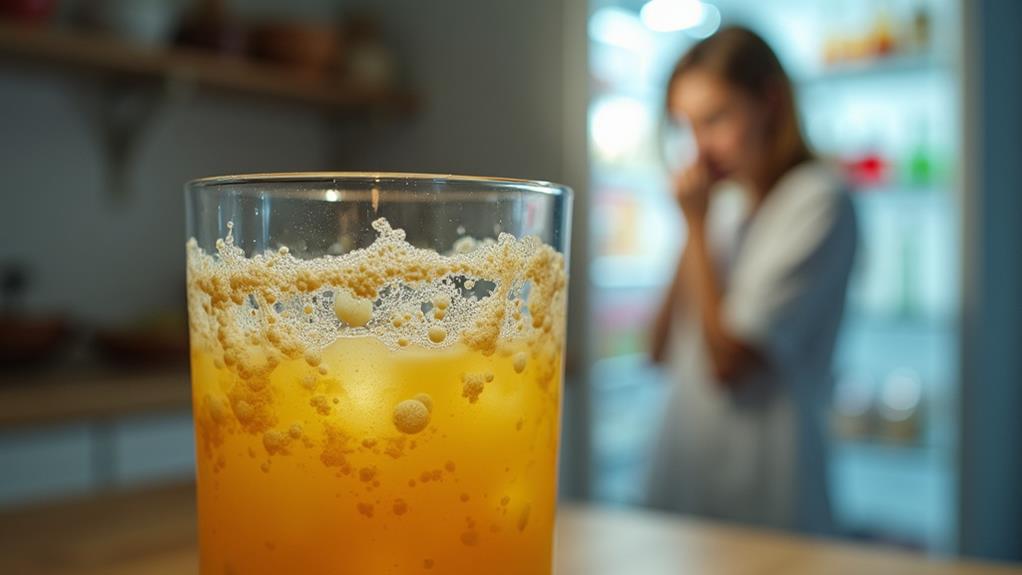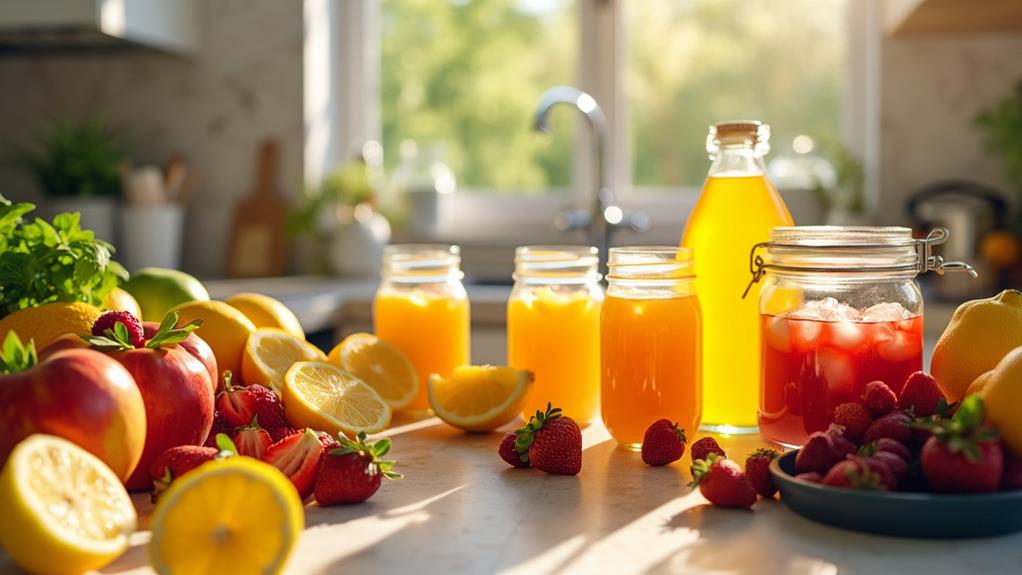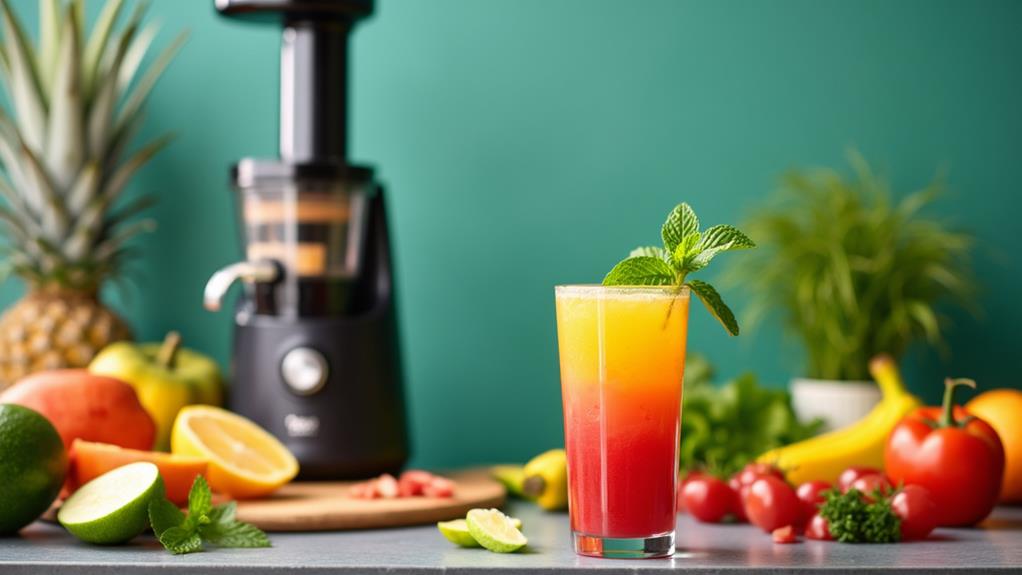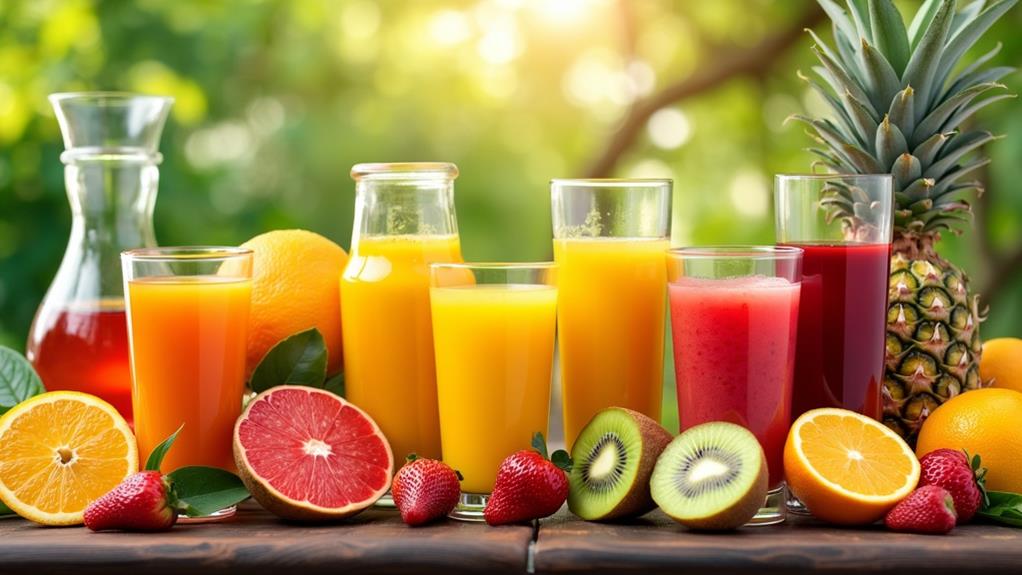Easy Homemade Fruit Juice Recipes
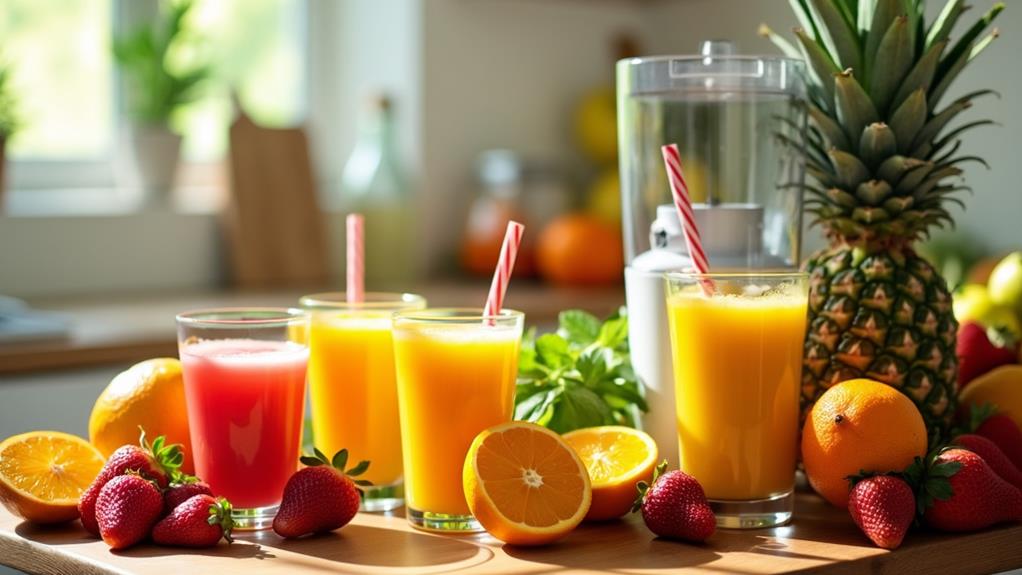
Making homemade fruit juices is a simple way to enhance your diet with fresh flavors and essential nutrients. By choosing seasonal fruits like mangoes, pineapples, and oranges, you can create delicious drinks without additives. Natural sweeteners can be added to adjust the taste to your preference. Interested in getting started? There are easy recipes and preparation steps available to guide you, offering both health benefits and hydration. Let's explore the key ingredients and techniques that make these refreshing beverages so easy to prepare.
Benefits of Fruit Juices
Drinking fruit juices offers a variety of health benefits, making it an effective way to boost your daily nutrient intake. Opting for fruit juices considerably increases your fruit consumption compared to eating whole fruits, ensuring you get essential vitamins, minerals, and phytonutrients needed for overall health and to prevent nutritional deficiencies.
Homemade fruit juice is particularly beneficial as it contains no additives or preservatives. Unlike many store-bought options, which often include high fructose corn syrup, homemade juice ensures you're consuming a pure, natural beverage. This purity leads to numerous health advantages, including improved hydration during warmer months due to the high water content in many fruits.
Regular consumption of fruit juices can also enhance immune function, aid digestion, and contribute to better skin health through their antioxidant properties. These antioxidants help combat free radicals, reducing oxidative stress and promoting a healthier complexion. Incorporating homemade fruit juice into your diet means enjoying a delicious drink while investing in long-term health.
Key Ingredients
To make your homemade fruit juice, fill about one-third of your pot with fresh fruits to ensure a rich flavor and high nutrient content. Adding sugar is optional, depending on the natural sweetness of the fruits you choose. Remember, water is essential for diluting the concentrate and maintaining hydration.
Essential Fresh Fruits
Essential fresh fruits are vital for crafting flavorful and nutrient-rich homemade juices. Ensure that fresh fruit comprises about one-third of the juicing container to maximize both taste and nutritional content in every sip. Opt for seasonal fruits, as they are fresher, tastier, and more nutrient-dense compared to out-of-season varieties.
Diversifying your fruit selection is key. Incorporating apples, oranges, and berries into your juice not only enhances the flavor profile but also significantly boosts overall nutrient intake. If accessing fresh fruits year-round is challenging, consider using frozen fruits. They provide convenience and allow you to enjoy a variety of flavors regardless of the season.
Always wash all fruits thoroughly before juicing. This step is crucial for removing pesticides and dirt, ensuring your juice is as clean and healthy as possible. By focusing on the right fruits and proper preparation, you'll be well on your way to making delicious and nutritious homemade juices that everyone will love.
Optional Sweeteners
Selecting the freshest fruits is crucial, but incorporating optional sweeteners can elevate your homemade juice. Sweeteners like honey, agave syrup, and maple syrup allow you to tailor the sweetness to your taste. Begin with a small quantity and gradually increase it to avoid making your juice overly sweet.
Natural sweeteners such as dates and ripe bananas can also enhance the flavor of your juice while adding extra nutrients and fiber, making your drink healthier. Using sweeteners sparingly is essential to maintaining the health benefits of your juice, ensuring it remains a rejuvenating, low-calorie option.
Consider the natural sweetness of the fruits you use. Fruits like mangoes and grapes are naturally sweet and may need little to no extra sweetener. Here's a guide to help you choose the right sweetener:
| Sweetener | Benefits |
|---|---|
| Honey | Natural, adds antioxidants |
| Agave Syrup | Low glycemic index |
| Maple Syrup | Rich in minerals and vitamins |
| Dates | Adds fiber and natural sugars |
| Ripe Bananas | Enhances flavor, adds nutrients |
Mango Juice Recipe
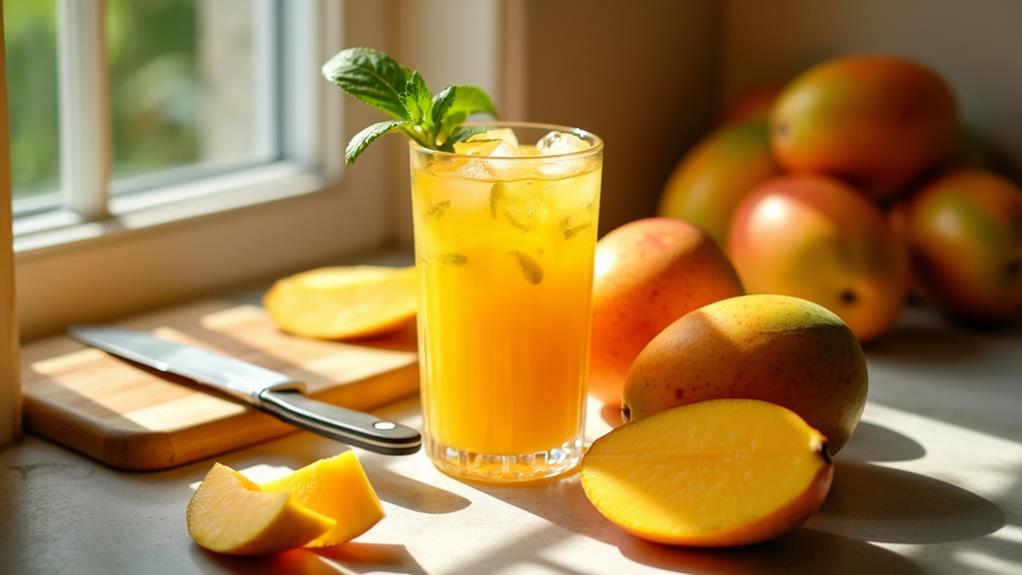
When mangoes are in season from May to July, it's the perfect time to make fresh mango juice. Alternatively, you can use frozen mango or mango pulp year-round. This juice is rich in vitamins A and C, which are beneficial for your eyes and immune system. Simply blend ripe mango flesh with water, then strain to achieve a smooth, additive-free drink that's ideal for summer.
Seasonal Mango Availability
Mangoes, typically in season from May to July, are ideal for making fresh mango juice. Using ripe mangoes for juice recipes not only results in a delicious beverage but also one rich in Vitamin C. Making homemade juice ensures you're getting all the natural benefits without added preservatives.
To make mango juice:
- Choose ripe mangoes: Select mangoes that are slightly soft and have a sweet aroma.
- Prepare the mango: Peel and chop the mangoes into chunks. One ripe mango usually yields about one cup of juice.
- Blend: Add the mango chunks to a blender with a small amount of water. Blend until smooth to achieve the desired consistency.
- Serve or mix: Enjoy the mango juice as is or blend it with other fruits for a refreshing twist.
While fresh mangoes are best, you can use frozen mango or mango pulp year-round. This ensures you can always enjoy homemade juice and its benefits, including vitamins A and C.
Nutritional Benefits Highlight
Dive into the nutritional powerhouse that is mango juice, and you'll quickly understand why it's a favorite among health enthusiasts. Mango juice offers a wealth of benefits that can enhance your well-being in numerous ways.
One serving of mango juice exceeds 100% of the daily recommended intake for vitamins A and C, essential for immune function and skin health. Its natural sugars provide a quick energy boost, making it an ideal choice for a revitalizing drink on hot summer days. Additionally, mango juice is rich in dietary fiber, which aids digestion and helps prevent constipation.
The high content of phytonutrients in mango juice gives it antioxidant properties that reduce inflammation and protect against chronic diseases. Regular consumption can also enhance eye health, thanks to lutein and zeaxanthin, which are beneficial for vision.
Here's a quick breakdown of the major nutritional benefits of mango juice:
| Nutrient | Benefit |
|---|---|
| Vitamin A | Supports immune function and vision |
| Vitamin C | Improves skin health |
| Natural Sugars | Provides quick energy |
| Dietary Fiber | Aids digestion |
| Phytonutrients | Reduces inflammation |
| Lutein & Zeaxanthin | Enhances eye health |
Incorporating mango juice into your diet ensures you're not only enjoying a delicious drink but also reaping substantial health benefits.
Simple Preparation Steps
With the impressive nutritional benefits of mango juice in mind, let's explore how you can easily prepare this delicious beverage at home. Making mango juice is straightforward and requires just a few simple steps. Here's how you can do it:
- Select and Prepare Mangoes: Start with ripe mangoes, ideally in season from May to July for the best flavor. Peel and chop the mangoes into small pieces to facilitate blending.
- Blend the Mangoes: Place the chopped mangoes into a blender. Add water—adjust the amount based on your desired consistency—and blend until smooth.
- Strain the Juice: For a smoother texture, strain the blended mixture through a fine mesh sieve or cheesecloth. This step removes any pulp, yielding a clear and refreshing juice.
- Sweeten and Serve: Taste the strained juice. If you prefer a sweeter drink, mix in a little sugar or honey. Serve the mango juice chilled over ice for a refreshing summertime treat.
Pineapple Juice Recipe
Homemade pineapple juice is a refreshing and nutrient-rich beverage that's simple to prepare. Begin by gathering fresh or frozen pineapple chunks. You won't need a specialized juicer; a blender works just as well. Blend the pineapple pieces with water until you achieve your preferred consistency. This method yields a vibrant juice packed with vitamins C and B6, along with manganese, all of which support energy metabolism and immune function.
For added zest, consider incorporating a squeeze of lime or a few mint leaves during blending. If you prefer a smoother texture, strain the blended mixture through a fine mesh sieve to remove any pulp, resulting in a clearer juice that's easier to drink.
Pineapple juice is not only delicious on its own but also highly versatile. It can serve as a base for smoothies or cocktails, providing an instant energy boost. With its sweet, tangy flavor and numerous health benefits, homemade pineapple juice is a fantastic addition to your healthy beverage options. Enjoy your refreshing creation!
Orange Juice Recipe
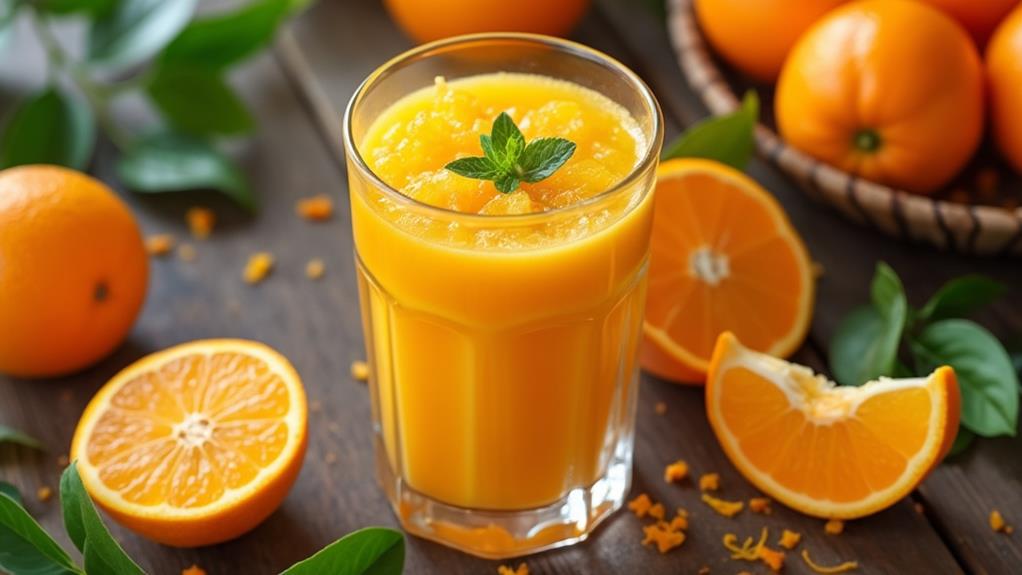
Orange juice is a staple in many households, and making it at home ensures you get the freshest, most nutrient-packed drink possible. To make orange juice, start by selecting the right type of oranges. Valencia oranges are ideal due to their high juice yield and sweet flavor. For a unique taste, consider adding Navel or Blood oranges.
Before juicing, wash the oranges thoroughly. Then, cut them in half and choose your juicing method: a manual juicer, citrus juicer, or centrifugal juicer. Typically, 3-4 medium oranges yield about one cup of juice.
Freshly squeezed orange juice is rich in vitamin C, antioxidants, and folate, enhancing your immunity and overall health. Here's a quick guide:
- Choose Valencia oranges for best results.
- Wash and halve the oranges.
- Use a manual, citrus, or centrifugal juicer.
- Consume within 2-3 days for maximum benefits.
You can use leftover pulp to add fiber to smoothies or other recipes, maximizing the use of your ingredients.
Juice Preparation Steps
To prepare your homemade juice, start by gathering your selected fresh or frozen fruits and placing them in a large pot. Fill the pot about one-third full with water. This step ensures optimal flavor extraction. Bring the mixture to a boil over medium heat, allowing the fruits to release their natural juices into the water, creating a rich base for your juice.
Once boiling, continue for an additional five minutes. Gradually add sugar to taste, depending on the sweetness of the fruits used. Take your time with this step to achieve the right balance of flavors.
After boiling, let the mixture cool before straining it through a fine mesh sieve or cheesecloth into storage containers. This removes pulp and solids, resulting in a smooth juice comparable to store-bought options. Store your homemade juice in mason jars in the refrigerator, where it can last up to 2-3 days.
| Step | Description |
|---|---|
| Gather Ingredients | Combine fresh/frozen fruits and water in a large pot |
| Boil Mixture | Bring to a boil over medium heat to release juices |
| Add Sugar | Adjust to taste based on fruit sweetness |
| Cool and Strain | Use a fine mesh sieve or cheesecloth to remove solids |
| Store Juice | Use mason jars; refrigerate for up to 2-3 days |
Ways to Enjoy
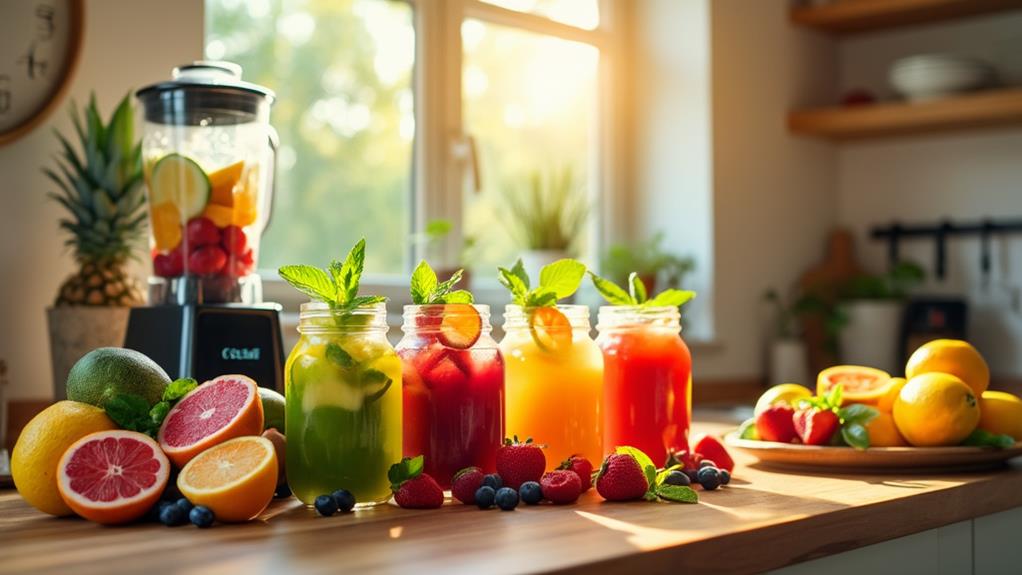
There are countless ways to elevate your homemade fruit juice from a simple beverage to a versatile ingredient in your culinary repertoire. Whether you're enjoying apple juice or another fruity blend, these ideas will enhance your experience:
- Chilled Over Ice: Serve your fruit juice chilled over ice to enhance its refreshing qualities, especially on hot days. The cold temperature makes it even more invigorating.
- Smoothies: Use your juice as a base for smoothies to add flavor and nutrition. Apple juice, for instance, blends seamlessly with other fruits and vegetables, creating a nutritious breakfast option.
- Cocktails and Mocktails: Craft creative cocktails and mocktails by mixing your homemade juice with spirits or non-alcoholic mixers. The unique flavors of your juice will elevate any drink and impress your guests.
- Sparkling Mix: Combine your juice with sparkling water or tonic for a fizzy, delightful beverage. Perfect for parties or casual get-togethers, this offers a refreshing alternative to plain soda.
Experiment with these methods to find your favorite way to enjoy homemade fruit juice!

